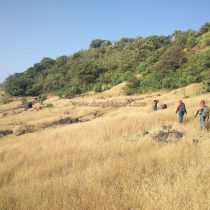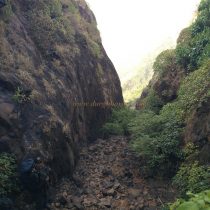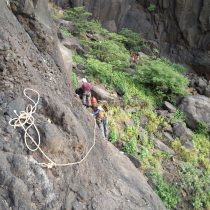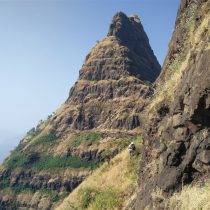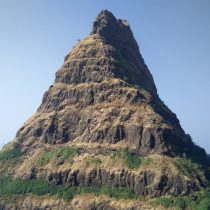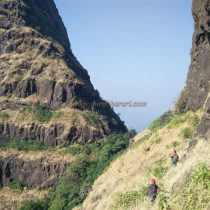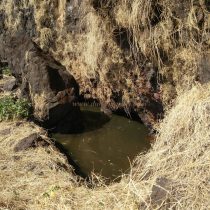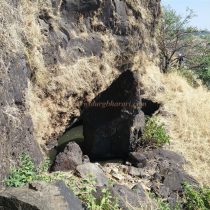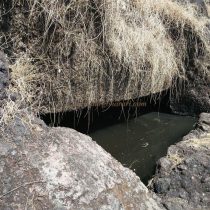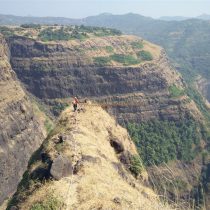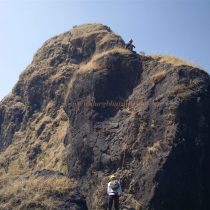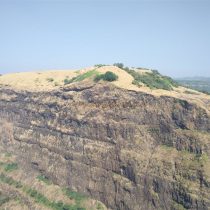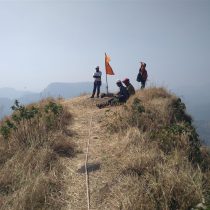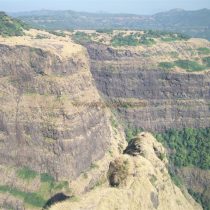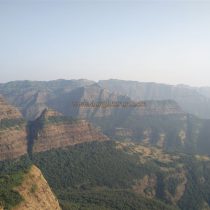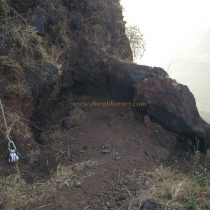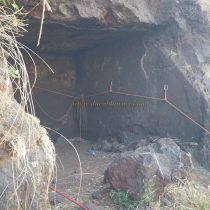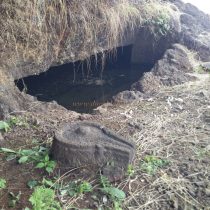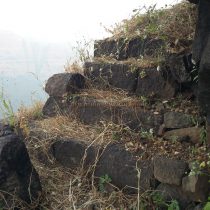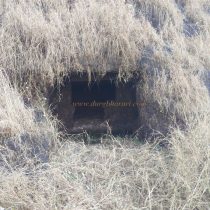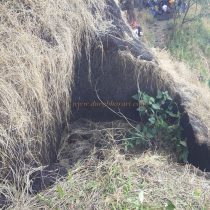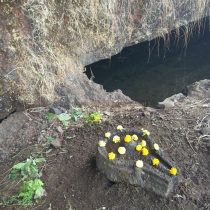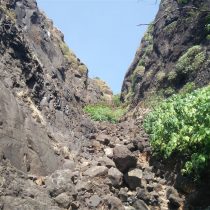LINGANA
TYPE : HILL FORT
DISTRICT : RAIGAD
HEIGHT : 2660 FEET
GRADE : VERY HARD
It is the dream of every mountaineer to climb the Lingana pinnacle and at some point, he has the desire to make this dream come true. Although mountaineering is not a preferable choice for some of the trekkers, the pinnacle of Lingana fort in the valleys of Kal river keeps attracting them and they have to take the risk of mountaineering to see Lingana fort. While visiting Lingana fort, Lingana pinnacle is also climbed in hand. It is my opinion that any person who is physically and mentally fit can climb Lingana if the basic rules for climbing are used. This pinnacle, which was considered impossible to climb till, December 24, 1978, was climbed by a group of 14 people including Santosh Gujar, T.V. Jadhav, Hira Pandit, Anil Patwardhan, and Vivek Gorhe on December 25, 1978, at noon.
...
Santosh Gujar, an expert climber who climbed Lingana for the first time, died accidentally on December 30, 1979, while climbing Lingana fort alone. Let us pay due respect to him and start visiting Lingana fort and the pinnacle. Currently, two paths are mainly used for climbing Lingana fort. The first route ascends from the Pane village in Konkan to the Machi of Lingana and from there to the fort. The second route descends from the village of Mohri on the top of the wharf through the Boratyachi Nal and into the gorge between the Ryaling Plateau and Lingana. To reach the fort by both these routes, it is essential to be aware of the technique of rock climbing as well as to have the equipment necessary for that. If you just want to climb the pinnacle, you have to be prepared to stay in the cave on the fort for one more day and the next day to tour the entire fort. There is the Mahad-Birwadi-Mangrun-Valankond-Pane road to reach Pane village and after an hour's climb, you reach Lingana fort’s Machi. It takes 1 hour from Lingana Machi to reach the remnants of the fort under the pinnacle and if you want to climb the pinnacle, it takes another hour to take a detour around the pinnacle and come to the gorge between the pinnacle and the Ryaling plateau. It takes about three to three and a half hours to get here from the base to this stage of the pinnacle. There is a Pune-Nasrapur-Margasani-Winzer-Velhe-Varotiphata road to reach the fort from Mohri village on top of the wharf. Since the road from the gorge is unpaved, it is better to have a jeep-like vehicle to reach Mohri village, otherwise, you will have to reach Mohri village on foot which takes about an hour. While trekking to Mohri village, Lingana pinnacle peeking from the Ryaling plateau and the Raigad fort behind it catches your eye. The village of Singapore has situated on a hillside a short distance from the village of Mohri. Lingana Machi can also be reached from this village by way of Dapoli village in Konkan via Singapore gorge. Mohari village is a small settlement of 10-12 houses. On the way out of the village, there is a big well carved in the rock and from this well, there is a path to reach the Ryaling plateau. As there is no water supply from here till half of the height of Lingana pinnacle, sufficient water should be filled from this well. The distance from Mohri village to the Ryaling plateau is about 3 km. After leaving Mohri village, we reach Ryaling plateau in about an hour by walking through a series of plateau-forest-plateau. Boratyachi Nal descends into the Konkan starting from the Ryaling Plateau and reaches a small ravine between the Ryaling Plateau and Lingana. On the left side of the Ryling Plateau, there is a small footpath that descends into the Borata Nal on the left. Before descending by this route, one would go a little further to the edge of the Ryling Plateau to visit Lingana, and from there turn back and begin to descend Boratyachi Nal. After carefully descending this path, you have to tie a rope to the nail on the wall and cross the 20 feet stage with the help of this rope. From there, we walk for about 15-minutes to reach a small ravine between Ryaling Plateau and Lingana. It takes about 2 hours to reach this gorge from Mohri village and from here the real Lingana climb starts. There are about 9 stages in the ascent of Lingana from the village in Konkan and if you come from Mohri village, you don't have to ascend from Pane village to Linganamachi and from Linganamachi to Ryaling gorge. There are a total of 7 stages to reach the pinnacle through Ryling gorge, of which four stages are difficult and the remaining three stages are normal. The first two stages are easy to climb and the first stage is a steep 50-foot vertical climb. After crossing the first two stages, you can see a path leading to the right. This path leads to the main part of the fort which is opposite to the place where you are. If you want to go to the fort or stay in the cave on the fort, keep your unnecessary materials here and start the next journey with the necessary food and drinking materials. After passing this third stage, you will see a half-extinguished and collapsed cave in front of you. To the right of this cave is another cave carved in the rock at the edge of the ridge at a height of 10-15 feet from the previous cave and in this cave, 10-12 people can easily stay. The caves carved here are carved for the guards and may have been used to monitor the paths descending from the Boradyachi Nal and the Singapore Nal. From the left side of the cave, there is a path leading to the pinnacle but rather than going on this path, walk straight. After about 30-40 feet, you will see a group of three cisterns carved in the rock. One of these small cisterns is partially carved, the second cistern is deeply carved in the rock and the third cistern is pillared. Next to these cisterns is a half-carved cave at 80-90 feet. The original fort is up to here and the upper part is just a pinnacle and this is where the difficult climb begins. The height from the creek to the cave is about 500 feet and the top of the pinnacle is about 400 feet from here. If you only want to see the fort, your ascent ends over here in these three stages and the remaining four stages are in the conical ascent. It takes one hour to reach here from the gorge and one hour to reach the pinnacle from here. From here, the entire ascent has to be done with the help of mountaineering equipment. There are a total of four steep climbs in this ascent. The first 50 feet steep climb is divided into two parts. It takes 3 hours to reach the top of the gorge and 5 hours from Mohri village. The top of the pinnacle is 2969 feet above sea level and a saffron flag is hoisted on the top. There is enough space on the head for 15-20 people to stand. From the top there is the Ryaling Plateau, to the east is Rajgad, Torana aka Prachandagad and to the west is a scenic view of Raigad fort. The rivers flowing in the bottom of the fort, Pane village, Valankondi village, and Wagheri village looks like a picture from the top. While descending from the top, we descend the first two stages with the support of rocks and other natural substances around us, while the remaining two stages are descended by rappelling with the help of the rope. After descending these two stages, we come to the cave we saw at the beginning. If you run out of water nearby, refill it and start walking. From here we tie the ropes to the nails in the big cave and the next two stages are crossed with rappelling once again. After descending these two stages, you come to the fort where you initially kept your luggage. From here, there is a path leading to the main part of the fort in the direction of Pane village, taking a detour around the pinnacle. This path is very steep and the place to walk on it is so less than your legs barely fit. In some places, there is not even this space so an iron rope has been built in that place. In two places, you have to cross this rope hanging. Looking down from this path, one might feel dizzy. This path has to be crossed bending, crawling, and sticking to the edge of the fort. Needless to say, if your foot slips! At the winding path of the pinnacle, you see four or five steps built. From here, when you look up at the cliff, you can see nails and iron ropes stuck in the cliff. From here, we go to the small Machi of the fort under the pinnacle and most of the remains of the fort are on this Machi. As the sunset is approaching, you should first go to the place of staying at the fort and see this part the next day. The path going straight from here is pretty decent and in this way, you can see big water cisterns carved in the rock. The water in the cistern is clean and does not taste bad. There is a Shivling carved in stone near this cistern. Going further from this cistern, you can see another dry cistern carved in the rock. The path leading from this cistern is destroyed and after descending into this cistern and sticking to the edge of the road, we reach the courtyard of a spacious cave. It takes 1 hour to reach the cave from the beginning of the path towards the gorge. The cave is excavated below ground level and can easily accommodate 30 to 40 people. Late Santosh Parshuram Gujar’s Samadhi is present near this cave. He died accidentally while descending the Lingana pinnacle. Coming to the fort from Pane village, we come to this cave from Lingana Machi. Your stay in this cave is pleasant because of the cool water in the nearby cistern, Raigad in front, and the warm cave. We didn't even notice that we haven’t eaten anything since morning because of the rush of climbing the fort and after eating in the cave, you get a good sleep. When you start your journey the next morning, keep your extra luggage in this cave and leave it in the direction of the steps you saw yesterday. These steps to the north of the fort are seen coming up from the lower side, which means that the original way to the fort from Lingana Machi must have been destroyed over time. There is an iron rope attached to the broken steps on the cliff. After climbing this 20 feet high cliff using the mountaineering equipment and techniques, on the way you can see the broken and partially buried frame of the gate on the top of the fort and the remains of the adjoining bastion. From here, after ascending a steep path 30-40 feet high, you can see the remains of a bastion and an outpost on the left. Machi of Lingana is 2032 feet above sea level and is spread over about 2 acres from south to north. A large number of remains are scattered on Machi. At the beginning of the road, there are two caves carved in the belly of the Lingana pinnacle, the first of which has a door and four windows carved in the rock. A stone slab can be seen outside this cave which is known as the prison or the administrative office of the fort. There is another cave carved next to this cave and this cave is known as a barn. In the next part of the cave, there are the quadrangle structures of small and big structures adjoining the edge of the cliff. The structure has a small cistern extinguished with soil. After seeing these remains, you will next see a water cistern carved in the middle of the Lingana pinnacle on the left. The water in this cistern is drinkable. There are remnants of 4-5 structures built in a line at this end of Machi which is sloping towards Raigad. During the Peshwa period, this place was known as ‘Jibhicha Pahara’. It is said that there were temples of the gods (Gaddevata) Shrijanani and Somjai around Lingana in this area but their exact location is not clear now. These deities are currently installed on the Lingana Machi under the fort. In this part of Machi, you can see the ramparts as well as the remains of a bastion. Remains on this Machi are mentioned in the documents as Hanmant Buruj, Paharyacha Buruj, Sarkarwada, Praveshdwar, but its location cannot be ascertained today. When you return to the cave after seeing Machi, your trek to Lingana fort is complete. It takes about an hour and a half to return to the cave. From here you can reach the village of Paane by descending on Lingana Machi by way of the slope, or by following the path you came up from and reach the gorge. From the gorge, we climb the Boratyachi Nal again and after walking for two to two and a half hours we reach Mohri village. After defeating Chandrarao More of Jawali, Lingana fort along with Raigad also came under the control of Shivaji Maharaj. After the treaty of Purandar, 23 forts were given to the Mughals. Lingana was among the remaining 12 forts that still belonged to Shivaji Maharaj. After Chhatrapati Shivaji Maharaj chose Raigad fort as the capital of Swarajya, he built a chain of forts like Mangad, Songad, Chambargad, Lingana around Raigad to strengthen it from the point of view of war. The Lingana fort must have been rebuilt mainly to keep an eye on the roads leading from Rajgad, Torna, Boratyachi Nal, Singapore Nal, Bocheghal down the forts in Sahyadri to Raigad in the Konkan. Although Lingana fort was built as a sub-fort of the capital, the caves and pillars on the fort testify to its antiquity. The fort is known as Lingana as its shape is like a Shivling. While describing the security pattern of Raigad, the documents also describe the security pattern of Lingana. Although Raigad Rajgriha and Lingana are known as prisons, there is no mention of Lingana prisons during Shivaji Maharaj’s period. Lingana is often referred to as a prison during the Peshwa period. Raigad is also mentioned as a prison during this period. According to the order given by Ram Raja, the successor of Chhatrapati Shahu Maharaj, on 30 August 1772 after the death of Madhavrao Peshwa, Raigad fort came under the control of the Peshwas. In 1773, it is mentioned that Lingana had 2 cannons, 2 small cannons, war materials, 2880 kg rice, and 5320 kg of Nachni grain. During this time, the Peshwas gave the responsibility of Lingana fort to Sambhaji Daund, Chimanaji Govind, and Khandoji Shelke and declared Devji Gopal as a Chief and gave him a salary of Rs. 150 and appointed Dhondo Narayan Mone as the clerk. In the year 1773-74, Santaji Nagoji Shelar was the head of the fort. During his time, it cost Rs. 30 to repair the mansion on Lingana Machi and also to repair the bastion which had collapsed due to heavy rains and to repair the guard bastion as well as to install a new wooden door instead of the old one. During the monsoons, about 2 kg or Rs. 1 worth of wax was applied to these doors. In 1774, a new bastion was built on Lingana. In the year 1775, the edge of Lingana collapsed and a huge stone fell on the road. With the help of labor and Patharwat, he broke the stone and cleared the way, and also completed the work of the bastion near the cistern. In the year 1777, many works were done for Lingana, such as a new prison cell, granary, guard post under the door, and repair of the road. The administrative office of the fort was rebuilt in 1780 at Rs 12. In 1779 and 1781, the cost of renovating Lingana fort was two rupees. The renovation work at Lingana fort was done at seven places namely Janani's temple, administrative office, Sarkarwada, Havaldar's house, Hanmant Buruj, Jibhicha Pahara, and Nigdi's Pahara. In the year 1785, it cost Rs. 32 to build a new mansion on the Machi of the fort. The Hanumanth Buruj, which collapsed in 1786, was rebuilt. It is mentioned that till 1786, Lingana's administrative office, bastions, gates, and granary were being maintained. It was a custom to sacrifice goats to the deities of Lingana (Gaddevata) and the gods Sreejanani and Somjai during the Navratra festival. At this time a saree of Rs. 1 was offered by the government to everyone for the Goddess. Koli Bhagat Kadu had a devotion to these deities. If any bad incident happens on Lingana, a pilgrimage is organized to God at Valankond. In the year 1784, due to a bad incident on Lingana, a pilgrimage was made to God at Valankond. During this pilgrimage, 50 paise was spent on coconuts, shendur, panchkhane, and betel nut for god. Goats are sacrificed every third year on Lingana. One goat was sacrificed for the gods of Shreejanani and Somjai and one for the gate for the fort. It is mentioned that male buffalo was sacrificed here in 1787-88. On Lingana, there was a tradition to distribute betel nut on the occasion of Dussehra and Chandradarshan and during this Chandradarshan i.e. Pournima a cannon was fired. A Shakarjatra was held on the fort and the cost of holding it was done by the government. Documents of all these expenses are found in the Peshwa Daftar. The soldiers on Lingana fort were 61 in 1775-76, 73 men in 1780-81, 51 men in 1781-82, 42 men in 1783-84, and only 6 men in 1808-09. In the year 1781-82, the total expenditure for the salary of 51 persons was Rs. 2833 and other expenses was Rs. 35, while in the year 1783-84, the total expenditure for the salary of 42 persons was Rs. 2042. Records of political prisoners, traitors, and homicide are seen to be in Peshwa Daftar. During 1775-1795 Gopalsheth Sonar (1775-1776), Ganeshbhat Paranjape (1779-1781), Mansingh Khalate (1783-1785), Moroji Naik Sankapal (1785), Mestarjama Farsisin (1792), Thaki Kondharkarin (1795-96) Anandrao Ramchandra Abhyankar (1798) these dignitaries were destined to be imprisoned. In the year 1780-81, Yesaji Naik Chandalekar was the fort keeper and Ganoji Naik was Sarnaubat while Mahadji Nilaji and Ramji Narayan were the Chief. In 1786-87, Rambhaji Daund became the fort keeper, but due to some mistakes in his work, he was imprisoned and Balkrishna Pandurang was appointed in place of him. This appointment lasted till 1795. After he died in 1795, Habajirao Rane became the fort keeper. Daulatrao Kunjir was the fort keeper of Lingana in 1808-09. The annual cost of maintaining Lingana was Rs. 3420 / - in 1795-96 and Rs. 3150 / - in 1813-14. After the fall of Raigad on 9 May 1818, Lingana fort was conquered under the leadership of Colonel Prother. The British army marched towards Pali on 23 May 1818. There are some important things to keep in mind while visiting Lingana fort. 1) The technique and experience of rock climbing, as well as basic knowledge and experience of mountaineering, should be known. 2) While ascending and descending the fort, small and big stones fall off the hill and might hurt you, so the helmet is necessary. 3) It is essential to carry all the items required for rock climbing. 4) To climb Lingana, you should leave Mohari village very early in the morning, so you don't have to climb in the hot sun. 4) If you visit the fort through Pane village, if possible, consider taking Baban Kashiram Kadu from Pane village with you as a guide.
Note- This expedition was carried out through the mountaineering organization WILD TROOPS with the help of Sudesh Nangre, Siddhesh Gotad, and Harsh Handore.
© Suresh Nimbalkar

